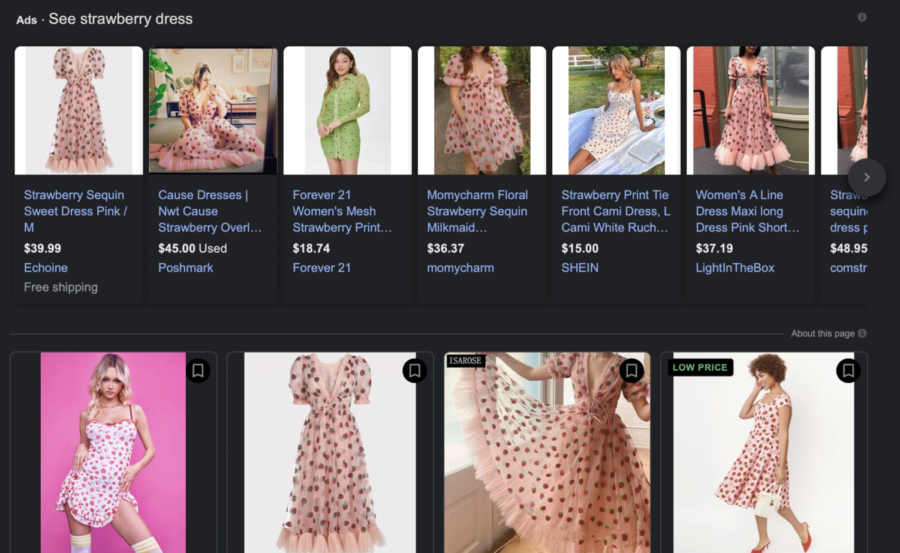Microtrends need to stop
The new phenomenon on Tik Tok is causing environmental harm.
The google search results for “Strawberry Dress” comes up with an alarming amount of fast fashion rip-offs.
February 5, 2022
Corsets, sweater vests, hibiscus print, Y2K and most recently “Twee” fashion — all clothing items and styles that became simultaneously popular and unpopular on Tik Tok within months. If you frequent thrift stores, you’ve probably seen quite a lot of these items on clothing racks. They have fallen into the trap of the infamous microtrend.
Microtrends have become a hot topic in fashion discourse across all platforms. Essentially, a microtrend is a clothing item or aesthetic that becomes popular for a short period of time, unlike macrotrends which usually last anywhere from 5 to 10 years. With the popularity of Tik Tok in particular, the time span of a microtrend has shrunk from a decent 2 to 3 years to a fragile 2 to 3 months.
Why don’t these trends last very long? The new democratized fashion industry where everyday people and influencers create trends has a hand at this. While a select group of fashion designers and celebrities used to drive trends through magazines and movies decades ago, social media with quick and formulated algorithms is able to quickly push certain videos to a wide group of people.
Any influencer with a brand deal can post a large PR haul and gain millions of views and any given clothing item or style can fully saturate fashion communities with millions of videos. This oversaturation, however, makes trends grow stale fast, meaning that trends don’t last long and clothes either get donated or thrown out.
Here lies a problem: microtrends are a large benefactor of textile waste that harms the environment.
The clothing industry, according to Business Insider, contributes to 10% of carbon emissions. 85% of textiles every year are thrown into landfills, with certain synthetic fabrics pushing plastic into the ocean. The earth is suffocating from the waste fashion industries produce.
When microtrends become popular, fast fashion companies notice. These corporations, like their name states, make units quickly, usually with poor construction made through unethical labor. With this business model, the fast fashion industry is able to capitalize on microtrends, but when the trends are over and the poor quality causes items to fall apart, the textiles are thrown out adding to the mountain of waste.
An example of this is the strawberry dress designed by independent artist Lirika Matoshi. The design had blown up to astronomical degrees on Tik Tok, with the dress originally priced at $490, something that normal teenagers and young adults could not afford. Fast fashion companies like AliExpress stole Matoshi’s design and made thousands of cheap recreations and consumers flocked to them, paying for poor quality over the original design.
The strawberry dress, though originally chic, has lost popularity and those who initially loved the dress threw it out. This is a fickle cycle that microtrends and fast fashion recreations cause, with clothes becoming popular and then becoming trash. Fast fashion is unavoidable for many people, as it is the most affordable option for many consumers. However, participating in microtrends is a conscious decision that can be avoided.
When you no longer want certain clothing items, donate rather than throw them out. You can opt for sustainable brands, which usually ethically make long-lasting clothing items, but if the costly prices are too much, look into shopping at local thrift stores. Building a unique personal style and overall consuming less fashion won’t solve the problem alone, but will lessen the impact microtrends have on our environment.
So next time you see a cute clothing item on Tik Tok, ask yourself, “Will I wear this in a year from now?”


